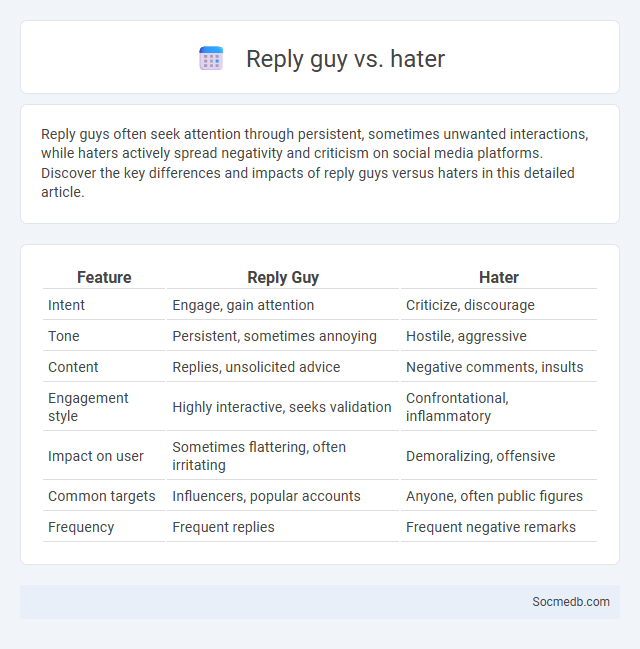
Photo illustration: Reply guy vs hater
Reply guys often seek attention through persistent, sometimes unwanted interactions, while haters actively spread negativity and criticism on social media platforms. Discover the key differences and impacts of reply guys versus haters in this detailed article.
Table of Comparison
| Feature | Reply Guy | Hater |
|---|---|---|
| Intent | Engage, gain attention | Criticize, discourage |
| Tone | Persistent, sometimes annoying | Hostile, aggressive |
| Content | Replies, unsolicited advice | Negative comments, insults |
| Engagement style | Highly interactive, seeks validation | Confrontational, inflammatory |
| Impact on user | Sometimes flattering, often irritating | Demoralizing, offensive |
| Common targets | Influencers, popular accounts | Anyone, often public figures |
| Frequency | Frequent replies | Frequent negative remarks |
Understanding the “Reply Guy” Phenomenon
The "Reply Guy" phenomenon revolves around individuals who frequently respond to others' social media posts, often in a persistent or unsolicited manner, aiming to gain attention or establish online presence. Recognizing these behaviors helps you navigate social interactions more effectively and maintain a positive digital environment. Identifying patterns like excessive commenting or interruptions can enhance your understanding of social media dynamics and personal boundaries.
Defining the Online “Hater”
An online "hater" is a social media user who expresses negative, hostile, or derogatory comments targeting individuals, groups, or content. These users often engage in cyberbullying, spreading toxicity that impacts mental health and online community dynamics. Platforms like Twitter, Instagram, and TikTok have implemented algorithms and moderation tools to identify and mitigate hater behavior for safer digital environments.
Distinguishing Reply Guy from Hater
Differentiating a Reply Guy from a Hater requires understanding intent and tone in social media interactions. A Reply Guy often aims to engage or correct, sometimes overenthusiastically or annoyingly, while a Hater typically expresses outright negativity or hostility. Your ability to recognize these behaviors helps maintain a healthy online environment and respond appropriately.
Motivations Behind Reply Guy Behavior
Reply Guy behavior on social media is primarily driven by the desire for validation and increased visibility within online communities. These individuals often seek to assert expertise or establish connections by frequently engaging with popular posts, aiming to gain acknowledgment from both the original poster and other users. Understanding your potential reactions to such interactions can help manage their impact on your social media experience effectively.
What Drives Haters on Social Media?
Social media haters are often driven by factors such as anonymity, which reduces accountability and encourages aggressive behavior. Psychological motivations include envy, insecurity, and a desire for attention or social dominance. The platform algorithms that amplify controversial content can also intensify negative interactions by rewarding engagement over civility.
Common Tactics Used by Reply Guys
Reply guys frequently use persistent comments and unsolicited advice as tactics to engage with social media users, often targeting women and public figures. These interactions can escalate into harassment or overwhelm conversations, reducing the quality of discourse within platforms like Twitter or Instagram. Being aware of these common reply guy behaviors helps you maintain control over your social media experience and set appropriate boundaries.
How Haters Interact Differently Online
Haters on social media often engage through aggressive comments, targeted harassment, and spreading negative content, distinguishing them from casual critics by their persistent and intense behavior. Their interactions typically include coordinated attacks or trolling, aiming to provoke emotional reactions and discredit individuals or brands. Unlike constructive feedback, these hostile engagements impact online communities by fostering divisiveness and reducing meaningful dialogue.
Recognizing the Impact: Reply Guy vs Hater
The distinction between a Reply Guy and a Hater on social media lies in their engagement intent and impact on user experience. A Reply Guy often seeks genuine interaction or clarification, sometimes persistently, which can foster ongoing dialogue, whereas a Hater typically intends to provoke negativity, spreading hostility and diminishing constructive communication. Recognizing these roles helps users navigate online communities more effectively, promoting healthier digital interactions and mental well-being.
Strategies for Managing Reply Guys and Haters
Effective strategies for managing reply guys and haters on social media involve setting clear boundaries through comment moderation tools such as filters and keyword blocking. Employing a consistent response plan that includes ignoring or diplomatically addressing negative comments helps maintain a positive online environment. Utilizing platform-specific features like muting, blocking, and reporting ensures that harmful interactions are minimized while protecting your digital reputation.
Fostering Healthy Online Conversations
Fostering healthy online conversations requires promoting respectful communication and implementing clear guidelines to prevent cyberbullying and misinformation. Encouraging active listening and empathy among users enhances meaningful interactions and reduces conflict. Platforms utilizing AI moderation tools help maintain a positive digital environment by quickly addressing harmful content.
 socmedb.com
socmedb.com